At this year's IEEE EMC+SIPI Symposium, Advanced Test Equipment Rentals' Jamison Berg, Electrical Engineer, and Gabe Alcala, Business Development Manager, provided a demonstration titled "Hands-On Verification of EMC Transient Waveforms: CE, Automotive, MIL-STD-461." Their demo outlined several pre-testing verifications of transients often seen in EMC testing, as well as how to certify your own products, calibration and verification of waveforms, and what to expect during certain EMC tests. If you missed the EMC Symposium or couldn't make it to their talk, here’s a recap of what Jamison and Gabe covered.
Commercial IEC/EN 61000-4-4: EFT / Burst
The commercial test for IEC/EN 61000-4-4 is used to demonstrate the immunity of electrical and electronic equipment when exposed to various transient disturbances, such as those that originate from switching transients (i.e. interruption of inductive loads, relay contact bounce, etc.). For this standard, EFT is tested at either 5 kHz or 100 kHz, depending on the product under test. The contrast between the transient in a 1000Ω load compared to a 50Ω load is not only output voltage, but the duration of the pulse lasting longer in the 1000Ω. Jamison and Gabe advised to be aware of a slight difference of rise time and duration specifications when coupling to power lines. In addition, when testing with a capacitive coupling clamp, its advised to use a ground plane (the specs will be the same as the generator output).
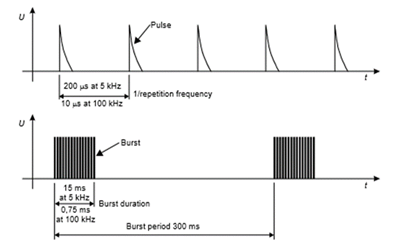 Commercial IEC/EN 61000-4-5: Surge / Combination Wave
Commercial IEC/EN 61000-4-5: Surge / Combination Wave
Similar to IEC/EN 61000-4-4, this test is applied to electrical components and systems where power system switching transients and lightning transients may occur. 61000-4-5 is tricky in that it requires a little math to take measurements accurately, so steady attention to detail is required (Peak +-10%). Here are a couple other things to keep in mind:
The undershoot is only measured at an output of generator, must be less than 30% max voltage. The generator characteristics should be measured through an external capacitor of 18 μF in series with the output. Both must be under open-circuit (load greater than or equal to 10 kΩ). Short-circuit conditions should remain at the same set voltage. If the 18 μF capacitor is implemented in the generator, no external 18 μF capacitor is required for calibration. Phase shifting performance should be met at the output of the CDN at 0°, 90°, 180° and 270° at one polarity. Residual surge voltage on CDN inputs should not exceed 15% of the max output voltage. The residual voltage on non-surged lines should not exceed 15% of the max output voltage. Coupling open circuit voltage specs change depending on the DUT current and short circuit current waveform. Impedance of the generator output is also a key difference when coupling relative to physical earth (PE).
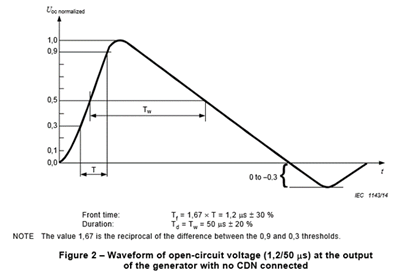
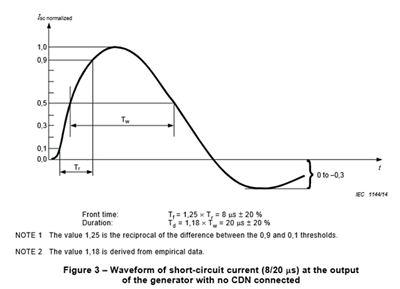 Commercial IEC/EN 61000-4-12: Ring/Damped Oscillatory Wave
Commercial IEC/EN 61000-4-12: Ring/Damped Oscillatory Wave
This test is complementary to IEC/EN 61000-4-5. A ring wave is induced in low-voltage cables due to the switching of electrical networks as well as reactive loads, faults, insulation breakdown of supply circuits, or lightning. This wave is a typical oscillatory transient, and is the most diffused phenomenon that occurs within a power supply. Testing parameters are as follows – O.C.: Rise Time = 0.5us+-30%, Frequency = 100kHz+-10%, S.C.: Rise Time <= 1us.
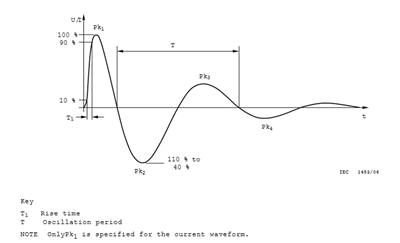 Commercial IEC/EN 61000-4-11: Power Fail/Dips & Drops
Commercial IEC/EN 61000-4-11: Power Fail/Dips & Drops
Network faults, short circuits, and sudden large changes of load can cause voltage dips or drop outs. Often times, two or more consecutive dips or interruptions can occur. These voltage variations create inefficiency of the operating system and may lead to power failure. To eliminate this risk of equipment failing, devices under test must not fail when the following conditions are met. Specified dip voltage must be within the 5% of max voltage, overshoot/undershoot should be no more than 5% of max voltage, rise and fall should be between 1us and 5us, and the phase angle within 10 degrees of set point. All of these parameters must be verified by using a 100Ω load.
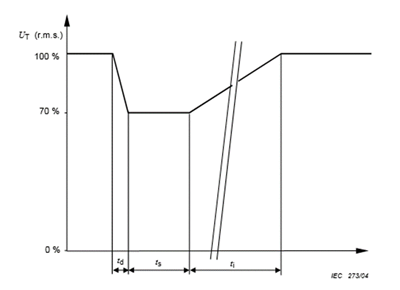 Automotive ISO 7637-2 Pulse 1
Automotive ISO 7637-2 Pulse 1
This test is a simulation of transients that are the result of supply disconnection from inductive loads. ISO 7637-2 Pulse 1 applies to a DUT if it remains connected directly in parallel with an inductive load, just as it would while being operated in the vehicle.
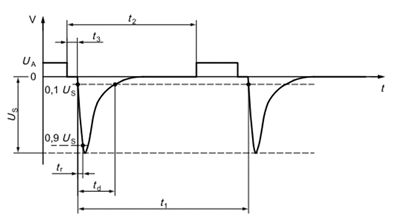 Automotive ISO 7637-2 Pulse 2
Automotive ISO 7637-2 Pulse 2
Pulse 2a simulates transients due to sudden interruption of currents in a device connected in parallel with the DUT due to the inductance of the wiring harness. In contrast, Pulse 2b simulates transients from DC motors acting as generators after the ignition is switched off.
Pulse 2a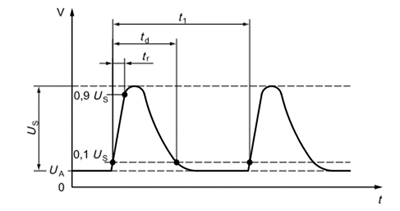 Pulse 2b
Pulse 2b 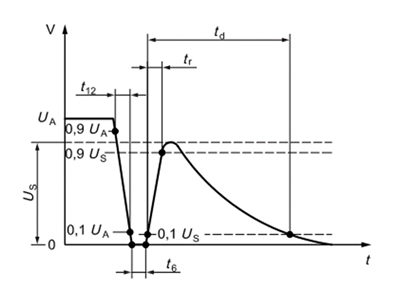 Automotive ISO 7637-2 Pulse 3
Automotive ISO 7637-2 Pulse 3
This series of test pulses are a simulation of the transients that have occurred as a result of the switching process. The characteristics of these transients are greatly influenced by the distributed capacitance and inductance of the wiring harness.
Pulse 3a.png) Pulse 3b
Pulse 3b.png) Military Standard 461G CS115
Military Standard 461G CS115
This test is required for applicable aircraft, space, and ground system interconnecting cables as well as power cables. It is also specified for applicable surface ship and submarine subsystems. Test system verification is all coaxial; it does not use any probes to take the measurement of the conducted pulse.
.png)
As for the typical measurement that should be seen on the oscilloscope, it should consist of a rise time and fall time < 2ns and a pulse width of at least 30ns with a 30Hz repetition rate.
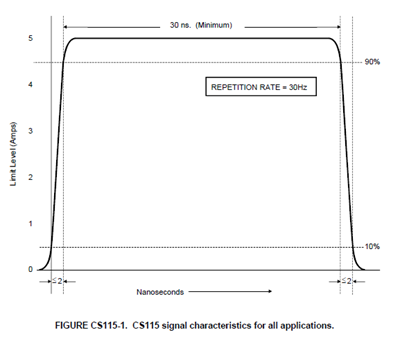 Military Standard 461G CS116
Military Standard 461G CS116
With similar requirements to CS115, testing applies to all interconnecting cables, power cables and high side power leads only. The test setup is identical to the previous test, given that it is made of coaxial measurements. Equipment under test (EUT) shall not malfunction and maintain its own operating criteria and specifications once exposed to these transients.
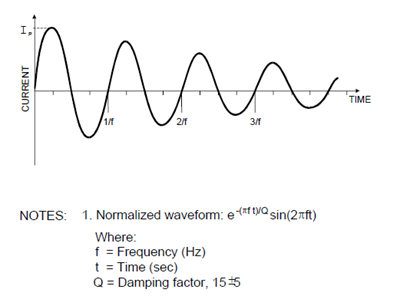
The most important measurements taken are the peak current, to verify you are testing to the correct level as stated in the standard, and the damping factor, to provide that the waveform is the correct shape over time, as well as frequency.
To learn more about EMC testing and test equipment, please feel free to contact our Advanced Test Equipment Rentals EMC team directly at 800-404-2832.